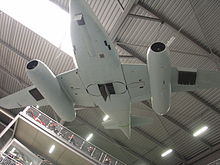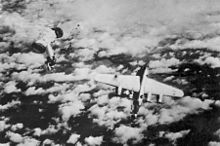
Armour-piercing ammunition (AP) is a type of projectile designed to penetrate armour protection, most often including naval armour, body armour, vehicle armour.

The Panzerfaust was a development family of single-shot man-portable anti-tank systems developed by Nazi Germany during World War II. The weapons were the first single-use light anti-tank weapons based on a pre-loaded disposable launch tube, a weapon configuration which is still used today.

The MK 108 is a 30 mm caliber autocannon manufactured in Germany during World War II by Rheinmetall‑Borsig for use in aircraft.

The Maschinengewehr MG 151 is a low caliber, belt fed autocannon for aircraft use, developed in Nazi Germany from 1934 to 1940 and produced by Waffenfabrik Mauser during World War II. It was originally produced in 15.1 mm caliber from 1940, chambered for a 15×96mm cartridge, but due to demand for higher effect against aircraft, especially with the introduction of mine shells for the 20 mm MG-FF/M aircraft cannon, the design was rechambered to 20 mm caliber in 1941, using a newly developed 20×82mm cartridge. The initial 15 mm variant then became known as the MG 151/15, with the new 20 mm variant becoming the MG 151/20.

The Royal Small Arms Factory ADEN cannon is a 30 mm revolver cannon used on many military aircraft, particularly those of the British Royal Air Force and Fleet Air Arm. Developed post-World War II primarily to meet British Air Ministry's requirement for increased lethality in aircraft armament, the cannon was fired electrically and is fully automatic once it is loaded.
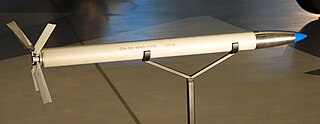
The Mk 4 Folding-Fin Aerial Rocket (FFAR), also known as "Mighty Mouse", is an unguided rocket used by United States military aircraft. It was 2.75 inches (70 mm) in diameter. Designed as an air-to-air weapon for interceptor aircraft to shoot down enemy bombers, it primarily saw service as an air-to-surface weapon. The FFAR has been developed into the modern Hydra 70 series, which is still in service.

The MG FF was a drum-fed, blowback-operated, 20 mm aircraft autocannon, developed in 1936 by Ikaria Werke Berlin of Germany. It was a derivative of the Swiss Oerlikon FF F cannon, with the Oerlikon FF design itself a development of the Imperial German World War I Becker 20 mm cannon, and was designed to be used in space-limited, fixed mountings such as inside aircraft wings, although it saw use as both an offensive and a defensive weapon, in both fixed and flexible format. It saw widespread use in those roles by the German Luftwaffe, particularly during the early stages of World War II, although from 1941 onwards it was gradually replaced by the Mauser firm's 20 mm MG 151/20, which was lighter, and had both a higher rate of fire and muzzle velocity.

The Vickers 40 mm Class S gun, also known simply as the Vickers S or S gun, was a 40 mm (1.57 in) airborne autocannon designed by Vickers-Armstrongs for use as aircraft armament.

The RP-3 was a British air to ground rocket projectile introduced during the Second World War. The "3 inch" designation referred to the nominal diameter of the rocket motor tube. The use of a 60 lb (27 kg) warhead gave rise to the alternative name of the "60-pound rocket". Though an air-to-ground weapon, it saw limited use in other roles. They were generally used by British fighter-bomber aircraft against targets such as tanks, trains, motor transport and buildings, as well as by Coastal Command and Royal Navy aircraft against U-boats and ships.
RS-82 and RS-132 were unguided rockets used by Soviet military during World War II.
Rüstsätze were field modification kits produced for the German Luftwaffe during the Second World War. They were packaged in kit form, usually direct from the aircraft manufacturer, and allowed for field modifications of various German aircraft used in World War II, predominantly fighter bombers and night fighters. Rüstsätze kits could be fitted in the field, as opposed to Umrüst-Bausätze kits, which were typically fitted in the factory. This was not a hard and fast rule, however; during production runs various Rüstsätze kits were often fitted by factories in order to meet Luftwaffe demands, and "/R" designations were also occasionally applied to more complex changes in an aircraft's airframe design that were much more suitably completed at production line facilities, as with a few of the "/R"-designated versions of the He 177A-5 heavy bomber.
The Rheinmetall-Borsig MK 103 was a German 30 mm caliber autocannon that was mounted in German combat aircraft during World War II. Intended to be a dual purpose weapon for anti-tank and air-to-air fighting, it was developed from the MK 101. Compared to the MK 101 it was faster firing, and was originally intended to develop a higher muzzle velocity than the MK 101. Unlike the MK 101, the MK 103 used a belt feed, allowing it to potentially carry a larger ammunition load. The MK 103 used electrically primed rather than percussion-primed ammunition. The operating mechanism differed from the recoil-operated MK 101 in that it used a combination of gas and recoil operation. After firing, gas pressure served to unlock the breech, while barrel recoil was used to cycle the action.

The High Velocity Aircraft Rocket, or HVAR, also known by the nickname Holy Moses, was an American unguided rocket developed during World War II to attack targets on the ground from aircraft. It saw extensive use during both World War II and the Korean War.

The 21 cm Nebelwerfer 42 was a German multiple rocket launcher used in the Second World War. It served with units of the Nebeltruppen, the German equivalent of the American Chemical Corps. Just as the Chemical Corps had responsibility for poison gas and smoke weapons that were used instead to deliver high-explosives during the war so did the Nebeltruppen. The name "Nebelwerfer" is best translated as "Smoke Mortar". It saw service from 1942–45 in all theaters except Norway. It was adapted for aerial combat by the Luftwaffe in 1943.

A mine shell or high-explosive, high-capacity (HEHC) in British military nomenclature, is a military explosive shell type characterized by thin shell walls and a correspondingly high quantity of explosives, much higher than the traditional high explosive shell type per caliber, meaning that mine shells trade fragmentation effect for a higher pressure wave effect when comparing to traditional high explosive shells.
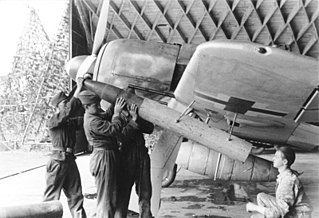
The Werfer-Granate 21 rocket launcher, also known as the BR 21 in official Luftwaffe manuals, was a weapon used by the German Luftwaffe during World War II and was the first on-board rocket placed into service by the Luftwaffe, first introduced in mid 1943. Based on the 21 cm Nebelwerfer 42 infantry barrage rocket system's hardware, the weapon was developed by Rheinmetall-Borsig under the leadership of Dipl.-Ing. Rudolf Nebel, who had pioneered German use of wing-mounted offensive rocketry in World War I with the Luftstreitkräfte.

Due to the Messerschmitt Bf 109's versatility and time in service with the German and foreign air forces, numerous variants were produced in Germany to serve for over eight years with the Luftwaffe. Additional variants were produced abroad totalling in 34,852 Bf 109s built.
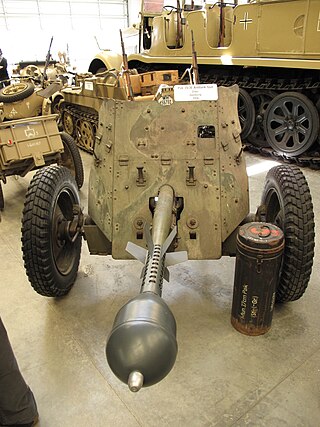
The Stielgranate 41 was a German shaped charge, fin-stabilized shell, used with the 3.7 cm Pak 36 anti-tank gun to give it better anti-tank performance.

Panzerblitz is a German anti-tank unguided aerial rocket developed during the Second World War.

